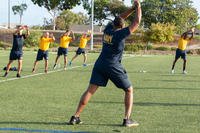When you see running workouts, you may see terms like "sprints," "easy jog," "fartleks," "intervals," "gassers" and even "goal-pace running." They all are references to different types of pace workouts, and they are all different -- some more different than others.
It is easy to get confused as to how you should train for timed runs, especially if you are new to running, have lost weight recently or still have weight to lose, or need to pass a fitness test.
Here is an email from a young man who has made tremendous progress with running and weight loss:
Stew, I need to pass a 1.5-mile fitness test run and get my time below 12 minutes (11:58 is the slowest I can go). I am currently at 13 minutes but have dropped from 16 minutes as well as 25 pounds at the same time. I still have some weight to lose but within the standard. Any recommendations? Still trying.
Great job with dropping mile pace and weight. Those are great accomplishments and show you have been working hard. The good news is, you don't need to change much of your current effort, but you should start training to run at a faster pace to achieve your next set of goals. And maybe you can lose some more weight, too (which will make you faster).
Here is how I would do it:
Evaluate how much you are running per week now. Keep it at that mileage but do it at a faster pace. You can run every other day with non-impact cardio activities, like bike, swim or elliptical, in place of running if you feel your joints, shins and feet need a break from the impact. But if you are feeling fine, try the following:
Your new goal pace requires running a quarter-mile in less than two minutes. You do not need to run it in 1:30 or even 1:45; instead, learn how to run each lap of the following workout at 1:55-1:58. This will give you a few seconds of "gravy time" in case you slow down on the last few laps, but it is not so fast that you expend all of your energy in the first lap. You have to think goal-pace strategy.
Here is the workout:
Run quarter-mile warmup -- any pace/stretch
Repeat 8-10 times:
- Run quarter-mile at goal mile pace (1:55)
- Walk 100 meters
Optional: Rest with another quick exercise for one minute (sit-ups, push-ups, squats, lunges). Alternate the above "rest exercises" every other set, if needed, or skip altogether.
I recommend the above workout three days a week, every other day. On the days in between, you can opt to do more running or non-impact cardio. However, the goal is different. Push yourself on these shorter/faster runs to help build your overall cardiovascular conditioning and speed. Mix in sprints, intervals, shuttle runs and fast/slow fartleks however you prefer. If you run, limit the distance to maybe a mile, but do a series of 50-, 100-, 200-, 300- and 400-meter sprints.
For instance:
Warm up with a fast 400 meters or two-minute bike/light stretch.
Increase your speed each set and avoid full sprints if you are getting older, have had some issues with tight hamstrings/calves or previously had pulled hamstrings. But you still can run faster than your goal pace above. That is the goal of the days in-between. Get winded each set and rest by walking back to the starting line.
Repeat 5 times
- 50-meter fast runs -- build up to full speed by set 4 or 5 (close to full speed)
- Walk back to starting line
Repeat 4 times
- 100-meter fast runs -- build up to full speed (after a few sets)
- Walk back to starting line
Repeat 3 times
- 200-meter fast runs -- fast -- much faster than one minute (half lap)
- Rest with a 200-meter walk
Repeat 2 times
- 300-meter fast runs -- fast as you can
- Rest with a one-minute walk
- Grand finale -- 400 meters as fast as you can.
- Stretch/cooldown jog or bike.
If you prefer non-impact activity, try bike pyramids, Tabata intervals and fast/slow intervals on the bike, elliptical or rowing machine. If you are into swimming -- push hard with the swim and work at 15- to 20-minute workouts in the pool.
Stew Smith is a former Navy SEAL and fitness author certified as a Strength and Conditioning Specialist (CSCS) with the National Strength and Conditioning Association. Visit his Fitness eBook store if you’re looking to start a workout program to create a healthy lifestyle. Send your fitness questions to stew@stewsmith.com.
Want to Learn More About Military Life?
Whether you're thinking of joining the military, looking for fitness and basic training tips, or keeping up with military life and benefits, Military.com has you covered. Subscribe to Military.com to have military news, updates and resources delivered directly to your inbox.

















